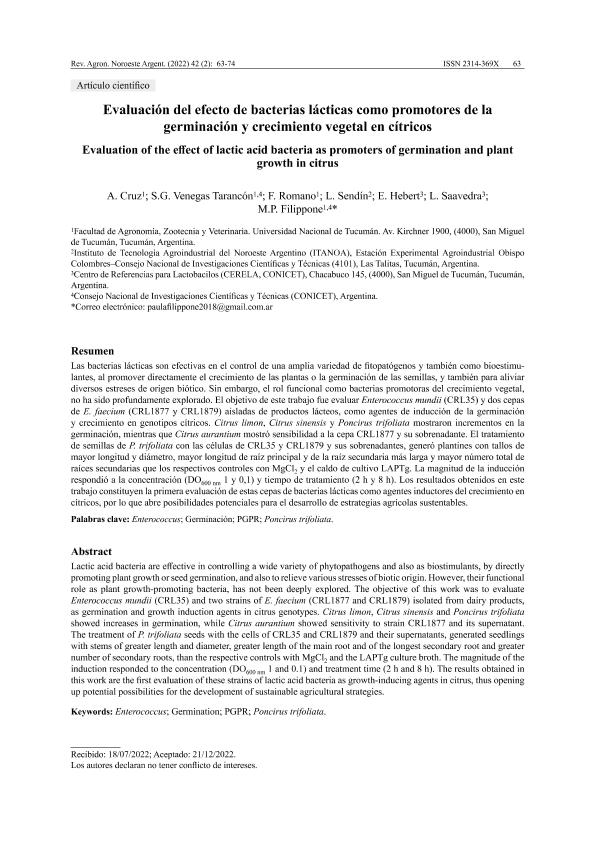Artículo
Las bacterias lácticas son efectivas en el control de una amplia variedad de fitopatógenos y también como bioestimulantes, al promover directamente el crecimiento de las plantas o la germinación de las semillas, y también para aliviar diversos estreses de origen biótico. Sin embargo, el rol funcional como bacterias promotoras del crecimiento vegetal, no ha sido profundamente explorado. El objetivo de este trabajo fue evaluar Enterococcus mundii (CRL35) y dos cepas de E. faecium (CRL1877 y CRL1879) aisladas de productos lácteos, como agentes de inducción de la germinación y crecimiento en genotipos cítricos. Citrus limon, Citrus sinensis y Poncirus trifoliata mostraron incrementos en la germinación, mientras que Citrus aurantium mostró sensibilidad a la cepa CRL1877 y su sobrenadante. El tratamiento de semillas de P. trifoliata con las células de CRL35 y CRL1879 y sus sobrenadantes, generó plantines con tallos de mayor longitud y diámetro, mayor longitud de raíz principal y de la raíz secundaria más larga y mayor número total de raíces secundarias que los respectivos controles con MgCl2 y el caldo de cultivo LAPTg. La magnitud de la inducción respondió a la concentración (DO600 nm 1 y 0,1) y tiempo de tratamiento (2 h y 8 h). Los resultados obtenidos en este trabajo constituyen la primera evaluación de estas cepas de bacterias lácticas como agentes inductores del crecimiento en cítricos, por lo que abre posibilidades potenciales para el desarrollo de estrategias agrícolas sustentables. Lactic acid bacteria are effective in controlling a wide variety of phytopathogens and also as biostimulants, by directly promoting plant growth or seed germination, and also to relieve various stresses of biotic origin. However, their functional role as plant growth-promoting bacteria, has not been deeply explored. The objective of this work was to evaluate Enterococcus mundii (CRL35) and two strains of E. faecium (CRL1877 and CRL1879) isolated from dairy products, as germination and growth induction agents in citrus genotypes. Citrus limon, Citrus sinensis and Poncirus trifoliata showed increases in germination, while Citrus aurantium showed sensitivity to strain CRL1877 and its supernatant. The treatment of P. trifoliata seeds with the cells of CRL35 and CRL1879 and their supernatants, generated seedlings with stems of greater length and diameter, greater length of the main root and of the longest secondary root and greater number of secondary roots, than the respective controls with MgCl2 and the LAPTg culture broth. The magnitude of the induction responded to the concentration (DO600 nm 1 and 0.1) and treatment time (2 h and 8 h). The results obtained in this work are the first evaluation of these strains of lactic acid bacteria as growth-inducing agents in citrus, thus opening up potential possibilities for the development of sustainable agricultural strategies.
Evaluación del efecto de bacterias lácticas como promotores de la germinación y crecimiento vegetal en cítricos
Título:
Evaluation of the effect of lactic acid bacteria as promoters of germination and plant growth in citrus
Cruz, A.; Venegas Tarancón, Stefanía Giselle ; Romano, F.; Sendín, Lorena Noelia
; Romano, F.; Sendín, Lorena Noelia ; Hebert, Elvira Maria
; Hebert, Elvira Maria ; Saavedra, Maria Lucila
; Saavedra, Maria Lucila ; Filippone, María Paula
; Filippone, María Paula
 ; Romano, F.; Sendín, Lorena Noelia
; Romano, F.; Sendín, Lorena Noelia ; Hebert, Elvira Maria
; Hebert, Elvira Maria ; Saavedra, Maria Lucila
; Saavedra, Maria Lucila ; Filippone, María Paula
; Filippone, María Paula
Fecha de publicación:
12/2022
Editorial:
Universidad Nacional de Tucumán. Facultad de Agronomía y Zootecnia
Revista:
Revista Agronómica del Noroeste Argentino
ISSN:
0080-2069
Idioma:
Español
Tipo de recurso:
Artículo publicado
Clasificación temática:
Resumen
Palabras clave:
Enterococcus
,
Germinación
,
PGPR
,
Poncirus trifoliata
Archivos asociados
Licencia
Identificadores
Colecciones
Articulos(CCT - NOA SUR)
Articulos de CTRO.CIENTIFICO TECNOL.CONICET - NOA SUR
Articulos de CTRO.CIENTIFICO TECNOL.CONICET - NOA SUR
Citación
Cruz, A.; Venegas Tarancón, Stefanía Giselle; Romano, F.; Sendín, Lorena Noelia; Hebert, Elvira Maria; et al.; Evaluación del efecto de bacterias lácticas como promotores de la germinación y crecimiento vegetal en cítricos; Universidad Nacional de Tucumán. Facultad de Agronomía y Zootecnia; Revista Agronómica del Noroeste Argentino; 42; 2; 12-2022; 63-74
Compartir



